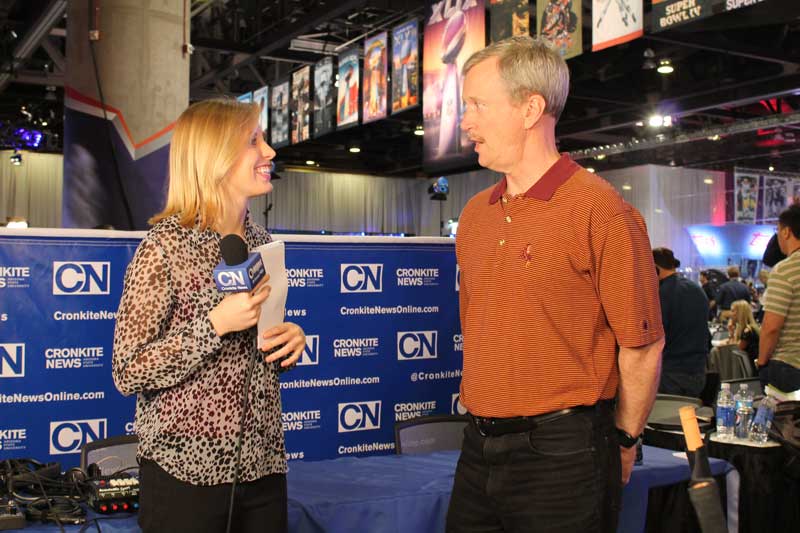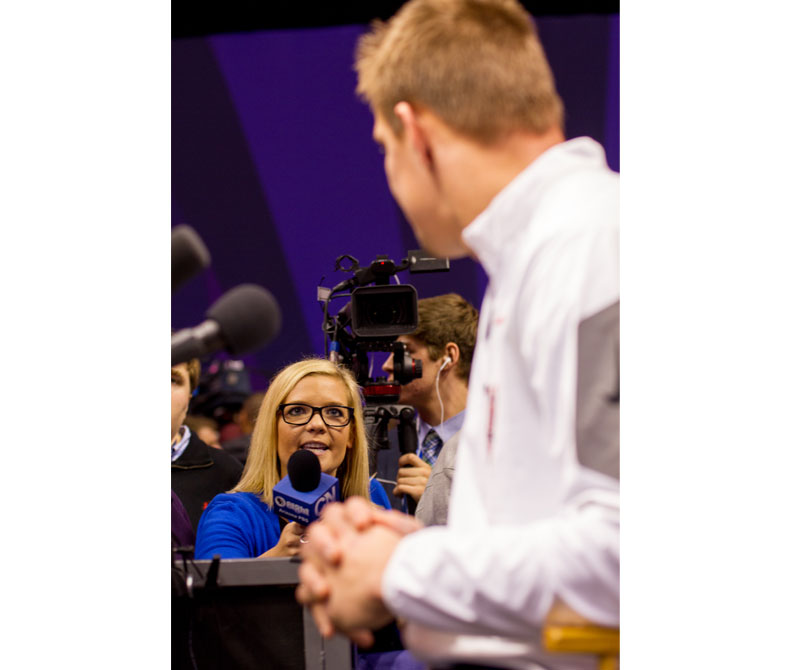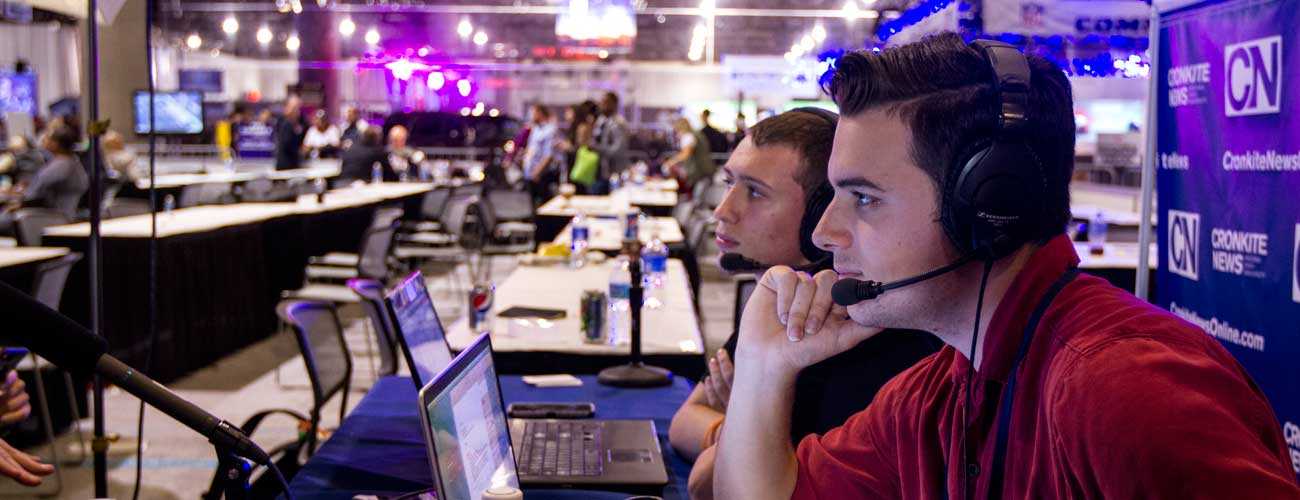With the expansion of broadcast networks, the rise of heavily trafficked niche outlets, and ever-popular local coverage, sports journalism is one of the few beats that can be called a media growth industry. That’s why universities are recalibrating to train students for the field. Not coincidentally, sports journalism programs are first emerging at colleges that have both a long-running school of journalism and a robust athletics department. It’s too early to fully measure the impact of these programs, but as pioneers, they have the potential to change the game when it comes to the reporting skill, historic background, and diversity of who’s making our sports media.
This fall, Arizona State University’s Cronkite School of Journalism & Mass Communication debuts its bachelor and master degree programs in sports journalism, its first standalone degree programs for a specific beat and perhaps the first of their kind nationwide. The University of Georgia’s Grady College launched a certificate program in sports journalism last year, the first SEC school to do so, and it’s seeing three times as many students apply than can be accepted. And Michigan State University has a sports journalist in residence, now entering her second year, who is helping to grow the school’s sports media focus area, including a 2016 conference on concussions and a new study abroad trip to Paris and Rome next summer.
This isn’t a wholly new trend—the University of Maryland opened the Shirley Povich Center for Sports Journalism in 2011 and Penn State founded the John Curley Center for Sports Journalism in 2003. But its widening reach is telling. Out of 1639 undergrads in ASU’s Cronkite School, about 189 have already declared a major in sports journalism in anticipation of the new program’s rollout. Fourteen grad students will pursue an MA in sports journalism this fall—nearly half of Cronkite’s total pool of 32 master’s degree students.

ASU student Kari Osep interviews George McCaskey, chair of the Chicago Bears. (Photo courtesy of ASU Cronkite School)
The Cronkite School has long had an unusually hands-on curriculum for journalism students interested in sports, including a spring training program, in which students cover Major League Baseball teams for outlets across the country that can’t send their own reporters to the Southwest. (For more on the changing baseball beat, see here.) Cronkite also has sports bureaus in Los Angeles and Phoenix, where dozens of students spend a semester developing written and broadcast content for professional outlets, including the Pac-12 Network and Fox Sports Arizona. The popularity of these programs partly inspired the new degree programs.
“We stepped back and realized how many signature events are in Phoenix and the state of Arizona,” says Assistant Dean Mark Lodato, citing the recent Super Bowl and Phoenix’s membership in the small club of cities that are home to all four major sports. “Along with the growing interest in sports journalism, we decided to take advantage of that.”
Turning fans into professionals
Scarcely more than 15 years ago, aspiring sports journalists trained to work in newspapers, television stations, or radio stations. ASU, like many other journalism schools (including Columbia), has broken down platform silos in its curriculum, wherein students select one medium over another. Now the program is designed for students to choose their favored beats, either in concentrations or dual degrees. That shift echoes what’s happening at the University of Georgia, where about 85 percent of students in the sports media certificate program are journalism students, but the rest are adding it to a completely separate major. “You could be, say, a philosophy major and get the certificate,” says Vicki Michaelis, a veteran sports reporter for USA Today who was tapped in 2012 to build UGA’s sports media program. “We want to provide a lot of flexibility.”
After years covering the Olympics, as well as high school, college, and pro teams, Michaelis was drawn into academia because she wants to help ensure that the next generation of sports journalists, “to whom the keys will be handed much more quickly than they were for us,” are grounded in reporting, ethics, and other foundational elements of journalism. “I’ve certainly heard kvetching about news outlets bringing in young people because they are digital natives and cheap, but then they don’t know what they’re doing,” Michaelis says. “I can help change that equation.”
I’ve certainly heard kvetching about news outlets bringing in young people because they are digital natives and cheap, but then they don’t know what they’re doing. I can help change that equation.
Georgia is a meaningful place to do that. One reason students come to universities like UGA is their love for the local sports culture. “That means one element you need (in a good sports journalist) is already there: You need to be really interested in sports,” Michaelis says. “I like to think we’re a good program, but definitely being in Athens, where Football Saturdays are pretty darn special, helps us a lot.”
But a unique problem for sports journalism programs is that students can easily mistake their fandom for genuine interest in the profession. This is a beat, after all, that’s infamous for its tight deadlines and brutal hours. “There’s a whole generation now that’s never known life without ESPN or the internet,” says Joanne C. Gerstner, Michigan State’s sports journalist in residence. She cites ESPN’s influence as part of the reason most student sports journalists are interested in going into broadcast.
Gerstner sees her role as “truth-telling.” Sports coverage means covering business, medicine, labor, public subsidies for stadium contracts, and both criminal and civil law. “It’s not just about giving my take on the (Detroit) Tigers,” Gerstner says. “It’s interesting to see them get that … . You don’t just go to the game and hang out and be LeBron James’ bestie.

(Photo courtesy of ASU Cronkite School)
“Effectively, we’re a working lab,” Gerstner adds. “I treat my classroom like a working newsroom, and I’m your sports editor. You’ve got to hustle, to be on point, and oh, by the way, you’ve got to get the bigger implications of what’s going on (in your stories).”
ASU prides itself on emphasizing inclusion over exclusion, and all interested students are welcome into the sports program. But Lodato emphasizes that core journalistic values are the backbone of the curriculum. “To make sure our sports journalism program was, frankly, just as strenuous as the news side of our program,” he says, “we morphed many of the terrific skill-based courses we’ve been teaching for decades on the news side and gave them a sports focus.”
Over in Athens, “we have to give (students) a real test, a taste of working in the business,” Michaelis says. On Day One of the introductory sports reporting class, students must write a deadline game story before the end of class–that is, in less than an hour. By the second week, students are at a local high school game, keeping statistics. She also assigns her students to UGA sports beats—equestrian, maybe, or men’s golf–but not to the beloved Bulldogs football team. Given the wild popularity of Georgia football, that zone is already flooded with media, and also filtered through a level of public relations orchestration that limits what students can learn.
One year after its official launch, the certificate program has graduated 10 students. Michaelis expects they will graduate an average of 25 or 30 as it gears up.
“Some people will decide, ‘It’s not for me,’” Michaelis says. “I’m totally fine with that. That should be one of our outcomes on a regular basis, because it means we’ve done our job in making this more than some type of tourism program.”
A new generation of sports journalists
To those wondering if a sports journalism degree is an unnecessary level of specialization for young reporters, Tom Feuer, director of ASU’s LA Sports Bureau, says there are a number of skills that are unique to the profession. Sports videography “is different in terms of framing your shots, in terms of backdrops, in terms of lighting,” he says. “It’s very different than general videography … so I think it would be very valuable for someone to come out of this school and already have that type of experience, rather than trying to figure it out on the job.”
Georgia, like ASU, prioritizes hands-on work that not only gives students experience but also professional clips. Students partner with the Athens Banner-Herald to livestream high school games and cover local schools as beat reporters under the byline of the “Grady Sports Bureau.” (For example.) “This allows us to do a little public service,” Michaelis says. “Local media outlets here are under-resourced and overworked, so this semester, with five multiplatform student beat reporters providing coverage of Athens high school sports … everybody wins.” Also, in August, the Atlanta Journal-Constitution launched a new blog called Dawg Nation, which is another platform Michaelis is eyeing for her students’ work. And a capstone course—that is, an internship—is required. Twenty students completed their capstone this summer at places like NFL Films, ESPN, and the American Junior Golf Association.
Some people will decide, ‘It’s not for me.’ I’m totally fine with that … because it means we’ve done our job in making this more than some type of tourism program.
When Michigan State’s sports media students go to Paris and Rome next summer, they will study Olympic history, international soccer, and how athletes are treated by media in different cultures. They’ll get to study Roman gladiators “in the original sports arena, the Colosseum,” Gerstner says.
The real-life working experience for students goes for faculty as well. In addition to the professional background of regular faculty, ASU has a sports communications class taught by the Arizona Diamondbacks’s vice president of communication. Georgia has a class taught by Daryl Orlando Ledbetter, the Falcons beat writer for the Journal-Constitution. Gerstner isn’t the first to teach sports journalism at Michigan State, but her unusual residency role comes with the expectation that she’ll still work as an active journalist. “It does give me credibility with students when I can fire up a story written for The New York Times last Tuesday, and I can say, ‘Let me tell you what happened with this story,’ ” Gerstner says.
That raises another point of promise for sports journalism on college campuses: to interrupt the distorted gender politics of sports media. Gerstner notes wryly that there have been more women on the space shuttle than there have been as sports editors. The lack of women managing, reporting, and discussing sports day-to-day feeds into the expectations of audiences. This was evident when one of Gerstner’s female students wrote a column for ISportsWeb about how Michigan State’s true rival these days is Ohio State, rather than Michigan. It was picked up by the Detroit Free Press—and ignited a phenomenal gender-tinged backlash against the writer. Readers doxxed her, shared her home address publicly, and urged her to get back in the kitchen. (She responded to the trolls in another column.)
That said, the Association for Women in Sports Media now has 12 student chapters, a number that has swelled just since the program’s launch in 2011-12. Arizona State, Georgia, and Michigan State all have chapters. And with a large number of female sports journalists in leadership roles in the new campus programs, there’s an opportunity to change the expectations of students of all genders.
“I do think it sends a powerful message to female students, who are being told various things by loved ones about how sports are not a thing that women do,” Gerstner says. “I can really talk to them, and say that you have the passion and talent, there’s nothing stopping you. I’m here. Why can’t you be?”
Anna Clark is a journalist in Detroit. Her writing has appeared in ELLE Magazine, The New York Times, The Washington Post, Next City, and other publications. Anna edited A Detroit Anthology, a Michigan Notable Book, and she was a 2017 Knight-Wallace journalism fellow at the University of Michigan. She is the author of The Poisoned City: Flint’s Water and the American Urban Tragedy, published by Metropolitan Books, an imprint of Henry Holt. She is online at www.annaclark.net and on Twitter @annaleighclark.

